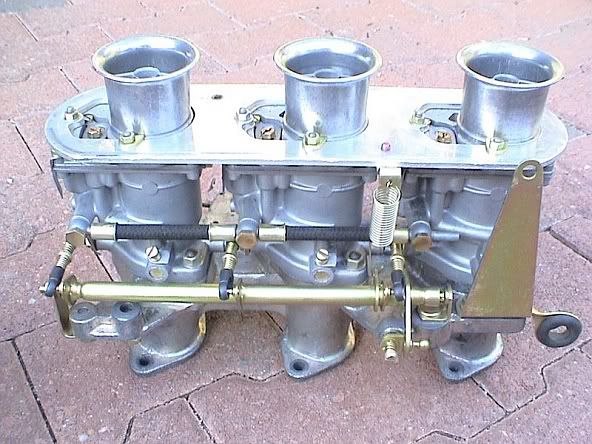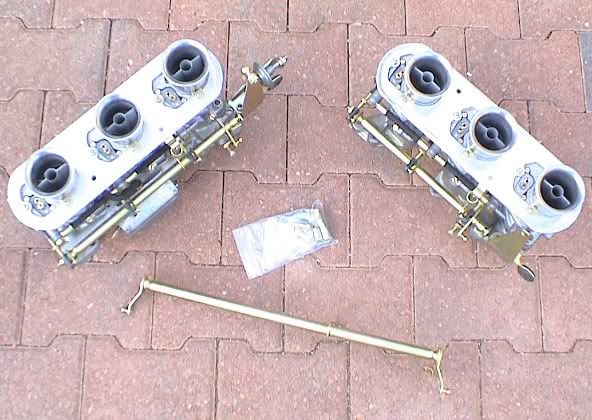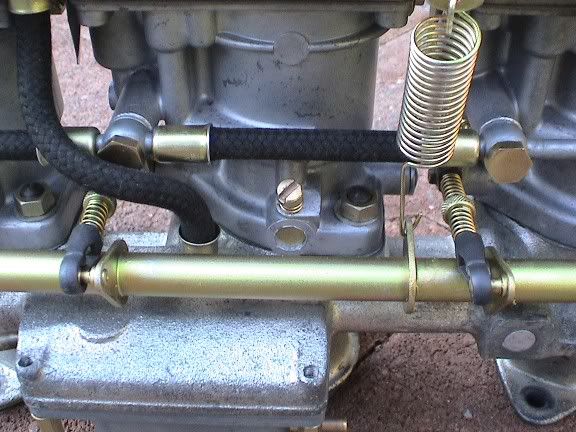Some of you will recall from my paint thread that after over 2 years of searching for a set of rebuildable Solex cores and nearly giving up, I finally found an acceptable set on Pelican. Again, thanks to John Cramer for his eagle eye. I'd have missed them without his pointer.
The set I bought were taken off of a ’65 back in the ‘80s and put them on a shelf. The car was owned by Jim Kaufmann, proprietor of 356 Carburetor Rescue, one of the top 356 Solex carburetor restorers. When he sold the car in 1990, he pretty much forgot about them until this year, when he decided to disassemble, replate, rebuild and rebush them, then post them for sale on Pelican.
Here they are:


In my research while trying to procure a set of these carbs, I came across tons of interesting and often conflicting information on these carbs. The one thing everyone seems to agree on is this:
- Very early on, it became apparent that the Solex carburetors were causing more problems than Porsche thought they were worth and switched to Webers.
In all fairness, Webers are very nice carbs and as we all know, have worked very well on 911s for a very long time. That said, they are a compromise design for the 911:
- The spacing of the Solex bores is a straight shot into the 911 intakes. Weber bore spacing requires offset manifolds, which is less than ideal from an engineering perspective.
- Webers don’t have chokes.
- Webers have a tendency to go dry in hard cornering without (albeit simple) modification.
Regardless of the advantages, for some reason, they just didn't perform well over time - the history and reasons are somewhat shrouded by the mists of time, but here is what I have been able to glean:
- Solexes worked just fine, off the lot, when new.
- At about the 4000 mile mark, they started to become cantankerous and difficult to tune.
- Porsche decided in mid-1966 that the Solexes would be phased out and replaced by the Webers. Owners with Solex cars could return the car to their dealer for a gratis retrofit.
- Most owners did and many owners go to keep their Solexes, too.
This brings us to today and the question of why did Porsche dump them? Why did they fail so quickly? Why did Porsche choose to replace them instead of fix, if it was possible? As we know today, making these carburetors run well is not only possible, they run better than Webers with the right modifications. What the "right" modifications are is open to debate and changes dependent upon who you talk to. The list of culprits I have heard from several experts:
- The axial relationship of the throttle shafts to the rocking motion of the motor, exacerbated by a poor busing throttle shaft bushing design caused the bushing to wear beyond spec in several thousand miles, leading to significant throttle shaft leaks.
- The emulsion tubes in the carbs were wrong sized from the factory
- Fuel overheating in the overflow system
- Sinking floats
- The small restrictor hole in the fuel supply union at each carb is too small at 1mm, which apparently guarantees fuel starvation when used in anger. There was a factory mod published late 1965 to drill them out to 1.2mm. For racing (long periods at full throttle / high revs) 1.3mm is a quoted minimum.
- The Pierburg dual diaphragm, camshaft driven, mechanical fuel pump are finicky to adjust. If not set perfectly, they either starve the carbs for fuel or flood the fuel system (they can only handle ~3 psi). Some also think that this pump’s ability to deliver fuel at a consistent rate was diminished over time due to wear.
So if these are the potential culprits, addressing them must result in a fix and this seems to be the case:
Duel Motorsports in Holland rebuilds these for a European vintage FIA racing class and their fixe runs the gamut: They do away with the mechanical fuel pump, ream the carbs for 356 Solex jets, drill out and replace the emulsion tubes, alter the bores and butterflies and rebush/ o-ring the throttle shafts with modern hardware.
Harry Bieker says that the above is fine for race cars, but to make Solexes work perfectly on a stock 911, only one modification is necessary: Rebushing and o-ringing the throttle shafts. Harry said that of the myriad sets he has rebuilt in several decades, only one set has ever come back for another rebuild and there have been no complaints of diminishing performance or tunability. He says that the mechanical fuel pump is adequate for a stock Solex car.
Grady Clay also cataloged some good info in this thread on Pelican, some of which is integrated into my post:
So where am I heading with all of this? The Solex carbs I just bought were completely gone through by a 356 Solex expert. It will be interesting to see which of these modifications, if any, he did. If none of them were done, I will try running them as-is, to test the “4000 mile wear” theory. If they are unaltered, it will be very interesting to see if and how they fail and this may be the last, best chance at uncovering the true mystery of the Solex failures in a Porsche 911.
Stay tuned – I should have my new-to-me carbs in hand next week and know if this is going to be possible. Below you’ll find some of the cool and hard to find parts I have collected over the years, as well. As they are all NOS (some are beat up, but nonetheless NOS as they have never been used), they provide an interesting reference point in this endeavor, as well.
EDIT: for reference, I have added an excerpt that shows all instructions on the installation, tuning and troubleshooting of Solex carbs.







 Reply With Quote
Reply With Quote